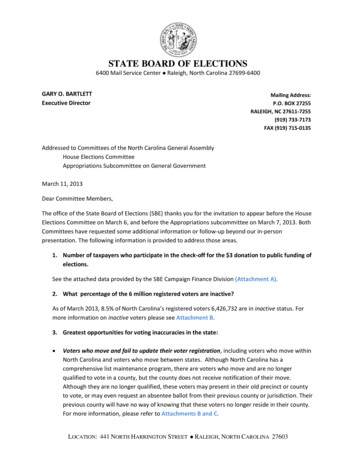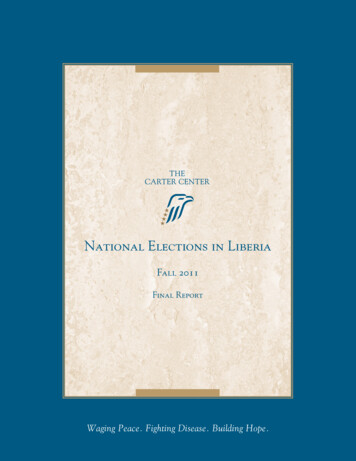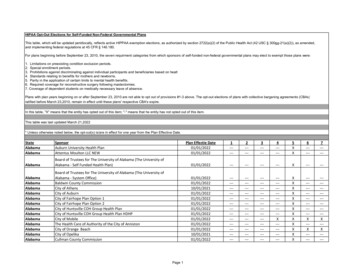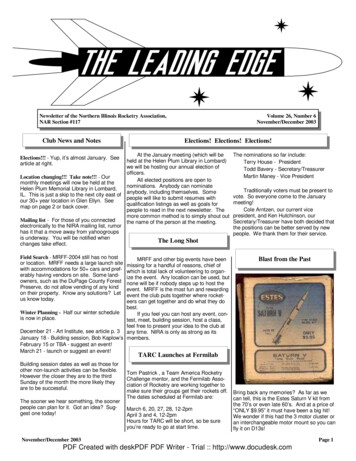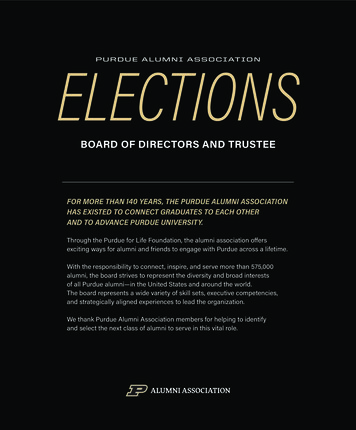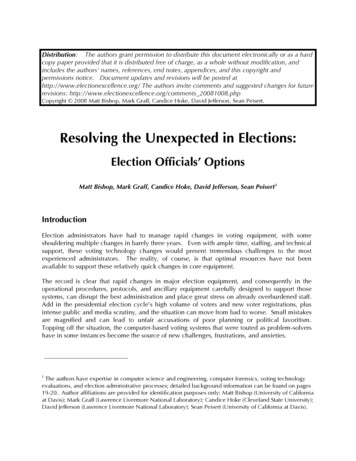
Transcription
Distribution: The authors grant permission to distribute this document electronically or as a hardcopy paper provided that it is distributed free of charge, as a whole without modification, andincludes the authors’ names, references, end notes, appendices, and this copyright andpermissions notice. Document updates and revisions will be posted athttp://www.electionexcellence.org/ The authors invite comments and suggested changes for futurerevisions: http://www.electionexcellence.org/comments 20081008.phpCopyright 2008 Matt Bishop, Mark Graff, Candice Hoke, David Jefferson, Sean Peisert.Resolving the Unexpected in Elections:Election Officials’ OptionsMatt Bishop, Mark Graff, Candice Hoke, David Jefferson, Sean Peisert1IntroductionElection administrators have had to manage rapid changes in voting equipment, with someshouldering multiple changes in barely three years. Even with ample time, staffing, and technicalsupport, these voting technology changes would present tremendous challenges to the mostexperienced administrators. The reality, of course, is that optimal resources have not beenavailable to support these relatively quick changes in core equipment.The record is clear that rapid changes in major election equipment, and consequently in theoperational procedures, protocols, and ancillary equipment carefully designed to support thosesystems, can disrupt the best administration and place great stress on already overburdened staff.Add in the presidential election cycle’s high volume of voters and new voter registrations, plusintense public and media scrutiny, and the situation can move from bad to worse. Small mistakesare magnified and can lead to unfair accusations of poor planning or political favoritism.Topping off the situation, the computer-based voting systems that were touted as problem-solvershave in some instances become the source of new challenges, frustrations, and anxieties.1The authors have expertise in computer science and engineering, computer forensics, voting technologyevaluations, and election administrative processes; detailed background information can be found on pages19-20. Author affiliations are provided for identification purposes only: Matt Bishop (University of Californiaat Davis); Mark Graff (Lawrence Livermore National Laboratory); Candice Hoke (Cleveland State University);David Jefferson (Lawrence Livermore National Laboratory); Sean Peisert (University of California at Davis).
Version 1.0Resolving the Unexpected in Elections2This paper recognizes the reality of election administration going into a major presidentialelection. It does not rehash the merits of e-voting or the debates over which type of votingequipment is better than others. Nor does it criticize the equipment undergoing final preparationsfor use in the November 2008 general election. All of these voting systems have plusses andminuses. Like most other computer-based equipment, these systems can be expected to performrelatively well for their intended tasks. But computer-based voting equipment also presentspossibilities of some unexpected, technically odd behavior that can disrupt election preparations,balloting, or tabulation, and can lead to inaccurate results. A quick managerial review can oftenidentify the cause of the problem, and lead to a simple and complete solution, especially wherethe technology is familiar. But election officials have advised us that at other times they could notdetermine the cause and thus left it uncorrected, hoping the election would run smoothly andtotals would reconcile.This paper is designed to assist election officials in effectively handling the technical irritationsthat have been difficult to diagnose, allowing them to protect themselves and the public interestfrom unfair accusations, inaccuracies in results, and conspiracy theories. The paper’s primarygoal is to empower officials to recognize which types of voting system events and indicators needa more structured analysis. Its approach seeks to enable officials to evaluate what the next stepsshould be, and to help them prepare for an inquiry should they decide to schedule it. Theauthors emphasize that computers can produce incorrect results, because of programming errors,incorrect settings, or insufficient built-in safeguards. No deliberate wrongdoing need occur forcomputerized voting equipment to fail to perform correctly and no “operator error” needoccur—but these are points some fail to grasp when they lodge accusations rather than wait forthe truth to come out.An objective, arm’s-length examination conducted according to professional standards of alliedfields (primarily computer forensics) can: determine both causes and solutions for unexpected and unexplained technical issues; settle questions and lead to broad acceptance of the ultimate report of election results,despite serious questions triggered by a technical equipment performance problem; reduce or eliminate the need for a complete hand-count of affected ballots; stop wild speculations and the “rumor mill”; reduce election litigation; and enhance the public’s confidence in the election officials entrusted to conduct the electionsand reduce reputation injuries fueled by lack of objective information.Depending on the evidence made available, the quality of the team, and the scope authorized forthe review, election officials can obtain the information needed to resolve the problem, determineand validate election results, activate warranty repairs, and—in many cases—learn how to preventa recurrence. Others involved in resolving questions about election processes and results, such aselection agency lawyers, candidates and political parties (and their lawyers), initiative sponsors,advocates, consultants, vendors, and policy makers, may also find this paper useful.
Version 1.0Resolving the Unexpected in Elections3I. The ProblemDuring an election, an optical scanner may fail to read ballots consistently, or a server may freezeas it tabulates votes. Perhaps voting machine memory cards or optical scan ballots appear to bemissing in the canvass report. Every election cycle, experienced election administrators aroundthe nation anticipate and successfully cope with events like these. But sometimes initial andsecondary troubleshooting steps don’t work. Election results totals cannot be reconciled, forexample, or seemingly inexplicable equipment or software failures recur. The vendor’s manuals donot provide sufficient direction to correct the situation. Facing election reporting deadlines andlegal duties to report accurate totals, election officials need answers. What happened? Are totalsaccurate and complete? Can they in good conscience certify the results of this election before theanswers are found? Delays and unusual computer events can also raise questions from others.Candidates might want to know whether the problem affects their race, and whether the problemis serious enough for them to request a recount or other remedy.The technical explanations needed to answer such questions are in the realm of election forensics:the process of analyzing and discovering the causes and cures of odd technical occurrences thatoccur in elections and might have had an impact on the validity of the results. Since the problemsinvolve computers, as they often now do, then computer forensics—the specialized procedures,tools, and skills needed to diagnose complex hardware and software problems are likely a largepart of the expertise required. Unlike the television presentation of forensics, the forensics field isnot primarily criminal. Forensics specialists are, however, dedicated and expert mystery-solvers.Computer forensics specialists are trained to solve technical puzzles that require that they handlethe software, hardware, and other materials in a manner that is legally approved—which is asimilar context to that of election officials.The forensic specialists can be asked to determine: what caused the unexpected computerbehavior? Were the vote totals affected? Can the voting records be recovered? How can weprove the voting data was not injured, to public satisfaction? Even jurisdictions that use voterverified paper ballots will find that this form of balloting is often not enough to answer odditiesthat will need to be resolved, for instance, to explain a discrepancy between electronic (computerproduced) and paper ballot vote counts.The authors of this paper recognize that few election offices are sufficiently large and wellresourced to have on staff or by contract an independent computer security or forensic specialist.Thus we have written this paper, drawing on the fields of election technology, computer forensics,and computer security, so that all election administrators and their counsel can consider whenadditional election troubleshooting and forensic steps should be taken. In this paper, we do ourbest to answer the following questions: When should election administrators consider an election forensic examination? What questions can the examination answer? How should they prepare for an examination? Who should be included on the forensic team? What sort of contractual provisions may be needed?Thus, this document provides an introductory overview to election forensics rather than aninstruction manual for a forensic examination.
Version 1.0Resolving the Unexpected in Elections4II. Indicators for a Forensic ExaminationDozens of technical problems, major and minor, can occur during an election. The specificproblems will depend on the particular voting technology used in the jurisdiction, the vendor, thesoftware version and configuration, and the kind of election involved (general, primary, special,recall, plurality, instant runoff/rank choice, etc.). The vast majority of technical problems aresimple, recognizable, and fairly routine, and can be resolved by standard procedures such asrebooting; replacing or recalibrating a piece of hardware; applying documented workarounds forknown problems; or by conducting cross-checks, pre-election tests, and post-election auditingprocesses. Such routine problems are familiar to election officials everywhere and clearly shouldnot trigger any formal examination.Occasionally, however, an event occurs that is outside the normal range of familiar problems. Asystem may crash, or yield inconsistent preliminary election results in one or more races. It maysimply behave in an unexpected way not previously seen or documented (sometimes called an“anomaly”), and perhaps not repeatable. Perhaps surprisingly, the very non-repeatability of aproblem may itself be a key indicator that something more fundamental is wrong. Such unusual orunexpected events could result from a hardware failure, a ballot definition error, an operator orpoll worker error, a previously unknown software limitation or bug, or a combination of suchcauses. Also, the possibility of election tampering through either malicious software or directhuman alteration of vote totals cannot be casually dismissed, though we will only briefly discuss ithere.A note on terminology: a problem should never be summarily described as a “glitch,” “hiccup,” or“computer error.” Such terms, and other similarly dismissive, pseudo-technical words andphrases, are inappropriate in serious contexts and thus should be eliminated from discussions ofelections technical irregularities. These words tend to minimize the significance of unusual orunexpected events by suggesting that computer behavior is somehow inherently unpredictable,that no human error could have been involved and thus the incident is not worth inquiry orremedy. On extremely rare occasions, a problem may indeed be caused by a transient, randomhardware failure, but those are far more rare than most people believe. It is safe to say that when aproblem occurs, some human error is involved, usually by a system architect, a vendor softwareprogrammer, a technical support contractor, an election official, or an IT staff member.Whenever a technical issue surfaces with voting equipment, election officials should undertake aninquiry as to its causes and cures. Even if a problem seems small and inconsequential, that doesnot necessarily mean the problem is trivial and needs no examination. Like the proverbial tip ofthe iceberg, small problems may be the only observable signs of large or systemic underlyingproblems. Even if the outcome of a particular race does not appear to depend on resolving theproblem, conscientious election officials should examine it. This inquiry helps both thejurisdiction where the irregularity surfaced as well as other jurisdictions, for often, like icebergs,the underlying problem is present elsewhere but without visible symptoms or indicators—whichmight mean the problem goes undetected when it most matters. All unusual or unexpected eventsin voting systems, as in any high reliability, high security computerized systems, should beexamined. One option to consider is a forensic examination of the computerized voting systemcomponents related to or potentially affected by the problem.Examples of the kinds of unusual or unexpected events that should be cause for considering aforensic examination are set out below. All of these events have occurred at one time or another
Version 1.0Resolving the Unexpected in Elections5in the last few years in at least one U.S. election. This list, however, should be considered asillustrative, and by no means exhaustive. Any unusual or unexpected behavior, even if not on thislist, should trigger consideration of a forensic examination.A. General problems with electronic voting equipment, such as: Repeated “crashes,” “freezes,” or auto-reboots of any voting system component Components that become slower and slower the longer they are in service Unusual episodes of unresponsiveness that last more than a few seconds Failure of some usually reliable functionality Unusual or undocumented error messages from the application software of any component Unexplained and undocumented new system behavior, even if it occurs only once Failure of a post-election logic and accuracy (L&A) test of any component (especially if thesame component passed its pre-election L&A test).B. Issues with election results, vote totals, or other data: Any unresolvable failure of vote totals, ballot counts, or voter counts to properly sum andreconcile with each other, or with audit trail records Unusually high numbers of overvotes, top of ticket undervotes, write-in votes, or votes forminor candidates or parties Vote totals that are obviously too small (or negative), or obviously too large, even if theyappear to reconcile properly Any inexplicable or illogical data (or indicators of data corruption), including in vote totals,database time stamps, or automatic audit logs.C. Specific issues with electronic equipment: Memory cards or cartridges that, when read repeatedly, appear to give different results, orread errors Memory cards or cartridges that are supposed to be redundant copies of one another, butdo not in fact contain identical data For direct recording electronic (DRE) systems, any discrepancy at all between the resultsreported electronically for a precinct and the results of a hand count of intact voter-verifiedpaper audit trail (VVPAT) records for that same precinct For DREs, multiple reinforcing reports of failure of the votes as recorded on the summaryscreen to agree with the voter’s tentative votes or with the VVPAT For optical scanners, any batch of paper ballots that, when read repeatedly by the same ordifferent scanners, yields counts that differ For optical scanners, any failure to scan and properly record the votes of a test deck thatcontains clean, correct marks.D. Problems reported from the field: Multiple corroborating reports from voters, poll workers, or county employees that the
Version 1.0Resolving the Unexpected in Elections6voting equipment is not functioning properly (regardless of whether they explain theproblem correctly.Regardless of whether they appear on this list, any technical events or data records that cannot beexplained and resolved are candidates for a forensic examination.III. Questions a Forensic Examination Can AddressIt is important that the members of the forensic team work with election officials to determine thequestions and parameters for the examination. The questions that the public may have most inmind for the forensic examination to answer are: Was the election called correctly? Or, Can wecorrectly announce the winners now? Answers to these questions, however, generally extendbeyond the technical issues the team is qualified to address. The examination will provide insightinto what caused the problem, how to recover voting data if necessary, and whether there aretechnical issues that would throw the results of the election into doubt. Election officials can thenuse this information in fulfilling their duties to certify accurate elections, and take care of valuableelection equipment.A. Some Appropriate QuestionsThe following are examples of technical questions that the forensic team may well be able toanswer. Obviously such questions should guide the examination, and not limit it. How many votes did the problem affect (minimum, maximum, best guess)? How accurateare the (preliminary) canvass totals? If the totals are wrong, can you recover the data (votes) needed to correct the totals? Is the computerized voting equipment operating in accordance with its documentation? Were any procedural guidelines violated that might have contributed to the cause of theproblem? Does the problem affect only this jurisdiction, or might other jurisdictions have the sameproblem? Did you find anything that appears, in your judgment, to be evidence of negligence,malfeasance, misuse, or attack? What can or should be done to prevent the problem from recurring, short term (in the wayof procedural workarounds) and longer term (in the way of software or hardware changes)?Officials might ask the team additional questions to obtain more detailed information, includingwhether the examination discovered anything that might indicate a significant malfunction of thecomputer hardware or software, a deliberate attempt (failed or successful) to affect the votestatistics or to interfere with voting, or serious errors in instruction manuals or documentation.B. Some Inappropriate QuestionsGood team members will restrict their focus to providing technical information, recommendations,and conclusions. Other questions lie beyond the elections forensic team’s expertise and they willnot be able to answer:
Version 1.0Resolving the Unexpected in Elections7 Should we get rid of these machines or buy more of these machines? (A business judgmentdecision.) Should we sue someone?decision.)(Asks for both a legal opinion and a business judgmentIV. Preserving Forensic EvidenceIf election officials decide that a forensic examination is a prudent next step, they should takepreparatory measures to increase the chances of success and reduce the possibility of procedural,technical, and legal errors. Later in this paper, we address a third area of preparation: laying legaland contractual foundations for the work.Forensic examiners gather evidence and analyze it to determine the nature, cause, and effects oftechnical problems. To make that possible, election officials must preserve the relevant evidence.Since examiners will not initially know what evidence they need and almost anything could beimportant, everything that might be relevant should be preserved. Where circumstances preventfreezing or capturing the evidence, for instance, an error message, a digital photograph can assistin documenting events and contexts for later use.All forensic examinations (election-related or otherwise) are based on the principle that theevidence must be preserved in a credible manner. The forensic examiners’ tasks require that theyinterpret the evidence to determine what happened in a way that others can validate. If theevidence is not preserved during the examination, the forensic findings are immediately suspect.Further, in a situation as volatile as an election, observers may want (or need) to validate theexaminers’ conclusions. If the examiners cannot show the evidence has been preserved, otherscannot perform this validation, raising questions about the examination’s results. In general,evidence handling should be minimized and the chain of custody should be tracked regardless ofwhether that evidence is on paper, data disks, software, logs, machines, networks, or somethingelse electronic. This means that election officials need to have a process in place for documentinghow to handle potential evidence. The process the jurisdiction normally uses to track paper ballotsmay be sufficient.The credibility of the forensic examination is paramount, and must be achieved in two separateways: first, credibility of the preservation of evidence; and second, openness of the examination. Ifpeople do not believe the evidence has been preserved, they will question the validity of theexamination’s conclusions. Here, the “chain of custody” records figure prominently. In addition, itis strongly recommended that no one ever be left alone with potential evidence including chain ofcustody records. This “two-person rule” means that at least two people can vouch for theaccuracy of the chain of custody records. This rule applies to original evidence; of course, oneperson can handle copies of evidence alone.Second, if an examination is conducted in secret, often the public response is to doubt its results,regardless of how well the evidence was preserved. Given that elections in the United States aretraditionally conducted openly, with a minimum of secrecy (for example, in some States, observerscan view every step of the process except the voter casting her votes in the booth). Thisexpectation of openness naturally extends to examinations of equipment issues that could affectelection results. Thus, the public should be able to observe all activities before and during the
Version 1.0Resolving the Unexpected in Elections8examination. Of course, this openness needs to be balanced with the need to maintain theconfidentiality of examiners’ discussions as they are conducting the review, and to protect thevendors’ proprietary information. For example, the California Top-to-Bottom Review [1,2] usedcameras to broadcast video to a public area apart from the secured facility where the “red team”analysis was conducted. Audio was not provided, however. Any member of the public could thuscome to watch the examination—and the examiners could speak freely about confidentialinformation and their testing and preliminary conclusions, without premature disclosures.A. Preserving Paper RecordsAll paper records relating to registration, voter sign-in at precincts, VVPAT records, and ballotsmust be preserved as required by law, of course, including spoiled ballots, provisional ballots,absentee ballots, and unused ballots, signed “zero tapes,” end-of-day precinct tally sheets, andsigned poll worker records. The examiners may need to re-reconcile the precinct voting data.1. A wide array of installation, inventory, and repair records is important, including those of: firmware and software versions hardware installations L & A (logic and accuracy) testing machine malfunctions, crashes, failures, and other prior unusual or unexpected behavior software patches installation workaround programs.If the records are not available, forensic examiners may also have to create a list of all files andsoftware, including version numbers and dates of installation and last modification.2. Precinct and voting records that might be needed include: serial numbers of the machines and memory cards that went to each precinct which memory cards were used in each machine precinct or early voting registries.3. Records of individuals’ access to the relevant machines and security equipment areequally important. These records should detail: names of people who had access to voting machines, and at what times and locations,including voting system vendor employees, poll workers, technical services contractors,transport and delivery personnel, and others who had custody of various pieces of systemequipment security video tapes chain of custody records for the voting machines, memory cards, paper ballots, and otherelection materials the numbers or codes of tamper-evident seals.
Version 1.0Resolving the Unexpected in Elections9B. Preserving MachinesA general rule is to preserve equipment when the problem is discovered. This section describeswhat to save. But in practice, if the problem occurs during the election, the equipment often mustcontinue to be used because the election cannot be stopped. In that case, copies of the data on theequipment—for example, making backups—will preserve much of the information for theexaminers. Digital photographic records can also prove helpful.For an electronic forensic examination, all voting system equipment, including the precinctdevices (e-voting machines, printers, monitors, registration check-in devices, etc.) as well ascounty-level devices (card readers, ballot counting devices, servers) should be preserved until theexaminers and officials determine the scope of the review. Further, if a computer or deviceinvolved in the election is running at the time the problem was discovered, it is best for theexamination if it is left running so that, for example, it is possible to determine what software wasrunning when the problem was discovered. If the device or computer was off when the problemappeared, it should be left off.If the machines are connected to a network, forensic experts will decide what to connect ordisconnect from the network. The network containing machines involved in the election shouldnot be altered. It should be left as it was when the problem was discovered. If this is not possiblebecause, for example, the machines are at a polling station, officials should keep detailed recordsof what staff did and any events that occurred after the problem was discovered. The physicalenvironment in which the equipment was located should be left undisturbed or, if that is notpossible, photographs and measurements should be taken.Additional equipment to preserve includes: Memory cards and sticks, which are critical components for review, so special care shouldbe taken to inventory and account for them. They are central to the security of the systemsand also typically contain automatic audit logs crucial to any examination. Any memorydevices should be left where they are. Other memory cards that are not in use should bepreserved and definitely not inserted into any machine. Under no circumstances shouldany memory card be modified or erased except by the forensic examiners, and governinglaw may prevent any changes in recorded memory. All redundant memory in the machines (as data in e-voting systems is generally stored onmultiple “independent” memory devices, all must be preserved). These vote records thatwere generated “closest” to the voters are a top priority. Poll closing tapes (e.g., from VVPAT printers, scanners, ballot marking devices). File systems and files on all relevant machines and devices.Once it is clear a forensic inquiry will be convened, no one other than forensic examiners shouldtouch any of the equipment or files. Everything connected with the election should be frozen andmaintained as close as possible to the state it was in when the problem was discovered.Preserving the environment and materials extends to the computer environment. No personnelshould create, open, edit, or delete files, run programs, log in or log out.
Version 1.0Resolving the Unexpected in Elections10V. Providing a FacilityDepending on the scope of the forensic examination, the team may require a secure area in whichto work, i.e., a physical facility with controlled access, such as a conference room or some officespace that can be locked and has alarms. The members of the forensic team should generally beable to control who is allowed to access that space. It should be large enough to house: Paper and other physical evidence The computers involved in the examination; the team can determine whether allcomputers need to be housed in the space concurrently Any other equipment relevant to the examination or that the team needs (for example,cameras, recorders, printers, laptops, etc.) The people on the team, as well as any other authorized personnel such as observers.The team will probably also want an office safe to lock sensitive material such as notes, disks, andlaptops when their protocol requires it, or when no one is present. Past examinations have foundsomething on the order of eight cubic feet of locked space to be adequate.Within the secured space, the team will need access to the Internet for sending and receivingemail and for conducting Web searches (which can be helpful when conducting forensic analysis).Under no circumstances will they connect any voting system component to the Internet. (Novoting system component should ever be connected to the Internet, even during forensicexamination.) Depending on the type of problem, the forensic team may, however, need toconnect the voting system components to one another or to their own computers for diagnostics,which will require one or more internal networks within the secured space. The best way toguarantee network security in the secured space is by keeping all other networks physicallyseparated from the one connected to the Internet.VI. Composition of the Forensic TeamAs described in the Introduction above, most technical problems that arise in elections are routine,and are handled without difficulty by election officials and their IT staffs. However, when anunusual, unfamiliar, or confusing event or result occurs, then much broader and deeper technicalex
1 The authors have expertise in computer science and engineering, computer forensics, voting . (University of California at Davis). Version 1.0 Resolving the Unexpected in Elections 2 This paper recognizes the reality of election administration going into a major presidential . The forensic specialists can be asked to determine: what caused .




